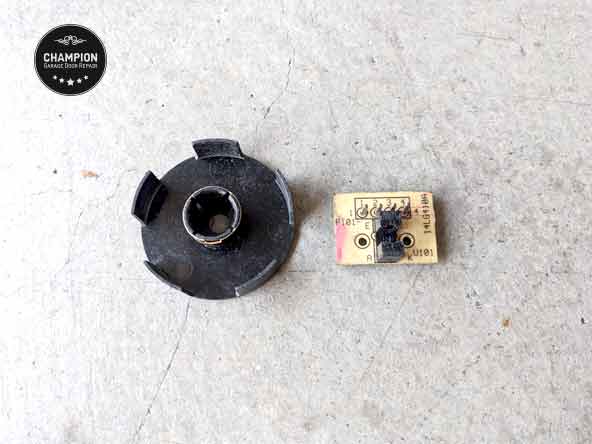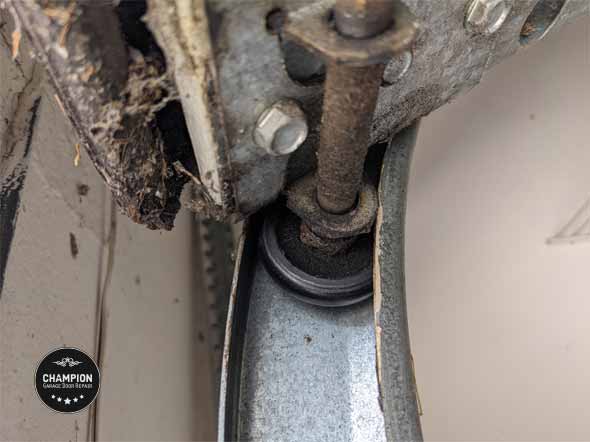By paying attention to warning signs, you can address garage door problems early on and avoid potential breakdowns.
Recognizing the signs that indicate your garage door needs repairs is essential for maintaining its functionality and ensuring your safety. By paying attention to specific signs and conducting a visual inspection, you can assess the condition of your garage door. Here are steps to help you determine if your garage door requires repairs:
- Listen for unusual noises: Pay attention to any grinding, squeaking, or scraping noises when opening or closing the garage door. Unusual garage door sounds can indicate issues with the door’s tracks, torsion assembly or bearings, springs, rollers, or opener.
- Check the balance: You can test the door balance by disconnecting the garage door opener by pulling the release handle (emergency release), then manually open the door to your waistline and shoulder level. If the door doesn’t stay in place or starts to close on its own, it may indeed be unbalanced and require adjustment. An unbalanced garage door can also indicate that the springs are worn out. Ensuring proper balance is important for the safe and reliable operation of the door.
- Observe the door’s movement: Watch the garage door as it opens and closes. Look for any jerking, shaking, or uneven movement, which could indicate problems with the tracks, rollers, or springs. However, it’s important to note that a minor deviation from the standard doesn’t necessarily mean there’s something wrong with the garage door.
- Inspect the springs: Look at the garage door springs to see if they appear damaged, stretched, or worn. Worn, damaged or broken springs pose a safety hazard and can affect the door’s ability to open and close smoothly and may require replacement. One way to identify a broken spring is by visually inspecting it for any visible signs of damage, such as being split into two with an approximate 2″ gap between the broken parts.
- Examine the cables and pulleys: Check the door cables and pulleys for any fraying, loose connections, or signs of wear. Damaged cables or pulleys can indeed lead to unsafe operation and should be repaired or replaced. A broken or misplaced cable can cause the garage door to come off the tracks, potentially leading to damage to the door panels, particularly in more extreme scenarios.
- Test the safety features: Garage doors are equipped with safety features such as photo-eye sensors and RPM sensor:
- Photoelectric Sensor: Garage door photo eyes consist of a transmitter sensor that emits electromagnetic radiation (EMR) and a receiver sensor that detects the emitted light. They are located on both sides of the garage door and are designed to detect objects or changes in surface conditions. When the sensors are obstructed or interrupted, it indicates the presence of an object, triggering a safety mechanism. The photo eyes specifically work to reverse the door’s operation when it is closing. You can test the functionality of the sensors by blocking the beam with a soft object like a paper towel roll or a soft cardboard box. If the sensors are working properly, the door will not close.

- RPM Sensor: The garage door opener’s RPM sensor measures the speed of the electric motor. If the sensor detects a sudden change in the motor’s speed, it converts this change into an electrical output. In practical terms, the RPM sensor is responsible for initiating the reversal of a vertically moving overhead garage door when it comes into contact with an obstruction. This safety feature ensures that the door stops moving to prevent damage or injury. You can test the functionality of the RPM sensor by placing a soft object like a paper towel roll or a soft cardboard box in the door way, then try to close the door on the object. If the RPM sensor is working properly, the door will not crush the object.

- Inspect the seals and weatherstripping: Check the bottom seal and weatherstripping around the garage door for any cracks, gaps, or deterioration. Damaged seals can indeed allow pests, drafts, and moisture to enter the garage. It’s important to note that dust particles and moisture can also cause damage to various components of the garage door, including bearings, springs, rollers, hinges, and opener components. This can lead to premature wear and affect the overall functioning of the door. Regularly inspecting and maintaining the seals and weatherstripping helps to ensure proper protection against external elements and extends the lifespan of the garage door mechanisms.
- Look for visual damage: Examine the garage door panels for any dents, cracks, or other visible damage. It is crucial to address any damaged panels promptly as they can affect both the appearance and functionality of the door. Operating a garage door with cracked panels can lead to a variety of problems, including difficulty in closing the garage door properly and the risk of the panels eventually buckling or collapsing.

Proactively and promptly addressing garage door problems is crucial for ensuring the safety of individuals and protecting property. Issues like malfunctioning sensors, worn rollers, or faulty springs can pose risks and potentially lead to sudden breakdowns, emergency repairs, accidents, or injuries if left unattended.
In addition to safety concerns, addressing problems early on also helps prevent further damage. A seemingly small issue, if left unattended, can escalate into a larger and more expensive problem. For example, a minor misalignment or worn-out component can gradually cause significant damage to the entire garage door system. By promptly addressing problems, you can avoid a costly garage door repair and even the need for a complete replacement.








